So! You’ve decided to take the leap into trying to conceive. As a very exciting (and sometimes nerve wracking!) time, a lot of things may feel overwhelming at first.
Here at Recharged PT, we’ve got all things pregnancy covered.
In the past, we have covered everything from what to expect each trimester to how to safely exercise and eat while pregnant. We have gotten into postpartum care and even the so-called “fourth trimester.” But another important factor to consider in your pregnancy journey is what to do before you get pregnant. Your lifestyle, mood and overall health can have a tremendous effect on your fertility and ability to conceive. And that is what we are here to talk about today. Aside from the mental, emotional, and relational dynamics involved in making this decision, your physical well-being is just as vital!














